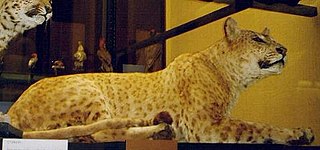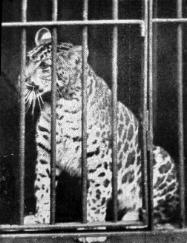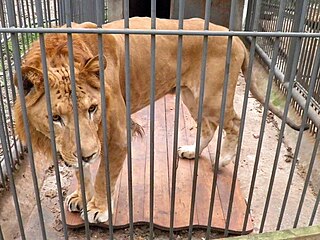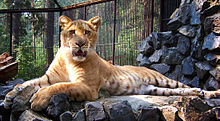
The tiger is the largest living cat species and a member of the genus Panthera. It is most recognisable for its black stripes on orange fur with a white underside. An apex predator, it primarily preys on ungulates, such as deer and wild boar. It is territorial and generally a solitary but social predator, requiring large contiguous areas of habitat to support its requirements for prey and rearing of its offspring. Tiger cubs stay with their mother for about two years and then become independent, leaving their mother's home range to establish their own.

The leopard is one of the five extant species in the genus Panthera. It has a pale yellowish to dark golden fur with dark spots grouped in rosettes. Its body is slender and muscular reaching a length of 92–183 cm (36–72 in) with a 66–102 cm (26–40 in) long tail and a shoulder height of 60–70 cm (24–28 in). Males typically weigh 30.9–72 kg (68–159 lb), and females 20.5–43 kg (45–95 lb).

A domestic long-haired cat is a cat of mixed ancestry – thus not belonging to any particular recognized cat breed – possessing a coat of semi-long to long fur. Domestic long-haired cats should not be confused with the British Longhair, American Longhair, or other breeds with "Longhair" names, which are standardized breeds defined by various registries. Other generic terms are long-haired house cat and, in British English, long-haired moggie. Domestic long-haired cats are the third most common type of cat in the United States.
The term "big cat" is typically used to refer to any of the five living members of the genus Panthera, namely the tiger, lion, jaguar, leopard, and snow leopard, as well as the non-pantherine cheetah and cougar.

The Bengal tiger is a population of the Panthera tigris tigris subspecies and the nominate tiger subspecies. It ranks among the biggest wild cats alive today. It is considered to belong to the world's charismatic megafauna.

A zebroid is the offspring of any cross between a zebra and any other equine to create a hybrid. In most cases, the sire is a zebra stallion. The offspring of a donkey sire and zebra dam, called a donkra, and the offspring of a horse sire and a zebra dam, called a hebra, do exist, but are rare and are usually sterile. Zebroids have been bred since the 19th century. Charles Darwin noted several zebra hybrids in his works.
A crossbreed is an organism with purebred parents of two different breeds, varieties, or populations. Crossbreeding, sometimes called "designer crossbreeding", is the process of breeding such an organism. While crossbreeding is used to maintain health and viability of organisms, irresponsible crossbreeding can also produce organisms of inferior quality or dilute a purebred gene pool to the point of extinction of a given breed of organism.

A Congolese spotted lion, also known by the portmanteau lijagulep, is the hybrid of a male lion and female jaguar-leopard hybrid. Several lijaguleps have been bred, but only one appears to have been exhibited as a Congolese spotted lion. It was most likely given that name by a showman because the public were more interested in exotic captured animals than in captive-bred hybrids.

A pumapard is a hybrid of a cougar and a leopard. Both male cougar with female leopard and male leopard with female cougar pairings have produced offspring. In general, these hybrids have exhibited a tendency to dwarfism.
A Panthera hybrid is a crossbreed between individuals of any of the five species of the genus Panthera: the tiger, lion, jaguar, leopard, and snow leopard. Most hybrids would not be perpetuated in the wild as the territories of the parental species do not overlap and the males are usually infertile. Mitochondrial genome research revealed that wild hybrids were also present in ancient times. The mitochondrial genomes of the snow leopard and the lion were more similar to each other than to other Panthera species, indicating that at some point in their history, the female progeny of male ancestors of modern snow leopards and female ancestors of modern lions interbred with male ancestors of modern snow leopards.

A felid hybrid is any of a number of hybrids between various species of the cat family, Felidae. This article deals with hybrids between the species of the subfamily Felinae.

A rosette is a rose-like marking or formation found on the fur and skin of some animals, particularly cats. Rosettes are used to camouflage the animal, either as a defense mechanism or as a stalking tool. Predators use their rosettes to simulate the different shifting of shadows and shade, helping the animals to remain hidden from their prey. Rosettes can be grouped in clusters around other spots, or may appear as blotches on the fur.

Nandankanan Zoological Park is a 437-hectare (1,080-acre) zoo and botanical garden in Bhubaneswar, Odisha, India. Established in 1960, it was opened to the public in 1979 and became the first zoo in India to join World Association of Zoos and Aquariums (WAZA) in 2009. It also contains a botanical garden and part of it has been declared a sanctuary. Nandankanan, literally meaning The Garden of Heaven, is located near the capital city, Bhubaneswar, in the environs of the Chandaka forest, and includes the 134-acre (54 ha) Kanjia lake.

Hybrid speciation is a form of speciation where hybridization between two different species leads to a new species, reproductively isolated from the parent species. Previously, reproductive isolation between two species and their parents was thought to be particularly difficult to achieve, and thus hybrid species were thought to be very rare. With DNA analysis becoming more accessible in the 1990s, hybrid speciation has been shown to be a somewhat common phenomenon, particularly in plants. In botanical nomenclature, a hybrid species is also called a nothospecies. Hybrid species are by their nature polyphyletic.

The white tiger or bleached tiger is a leucistic pigmentation variant of the mainland Asian tiger. It is reported in the wild from time to time in the Indian states of Madhya Pradesh, Assam, West Bengal, Bihar, Odisha, in the Sunderbans region and especially in the former State of Rewa. It has the typical black stripes of a tiger, but its coat is otherwise white or near-white and blue eyes.

The Zoological Garden, Alipore is India's oldest formally stated zoological park and a big tourist attraction in Kolkata, West Bengal. It has been open as a zoo since 1876, and covers 18.811 ha. It is probably best known as the home of the Aldabra giant tortoise Adwaita, who was reputed to have been over 250 years old when he died in 2006. It is also home to one of the few captive breeding projects involving the Manipur brow-antlered deer. One of the most popular tourist attractions in Kolkata, it draws huge crowds during the winter season, especially during December and January. The highest attendance till date was on January 1, 2018 with 110,000 visitors.

The tigon is a hybrid offspring of a male tiger and a lioness. They exhibit visible characteristics from both parents: they can have both spots from the mother and stripes from the father. Any mane that a male tigon may have will appear shorter and less noticeable than a lion's mane and is closer in type to the ruff of a male tiger.

The liliger is the hybrid offspring of a male lion and a female liger. Thus, it is a second generation hybrid. In accordance with Haldane's rule, male tigons and ligers are sterile, but female ligers and tigons can produce cubs. The first such hybrid was born in 1943, at the Hellabrunn Zoo.




















